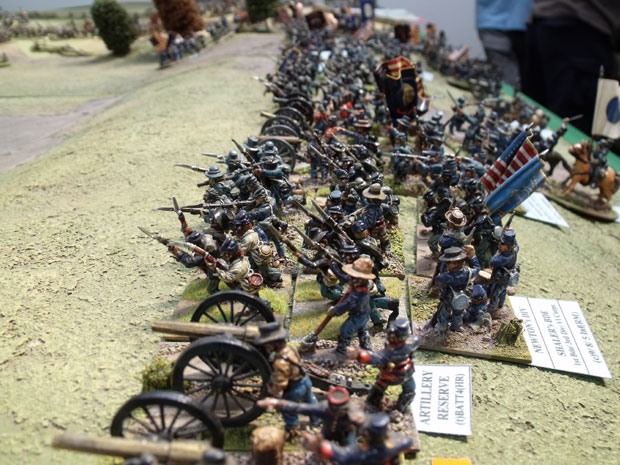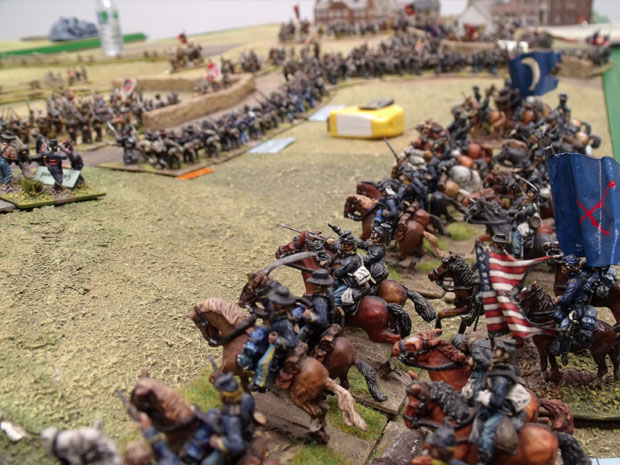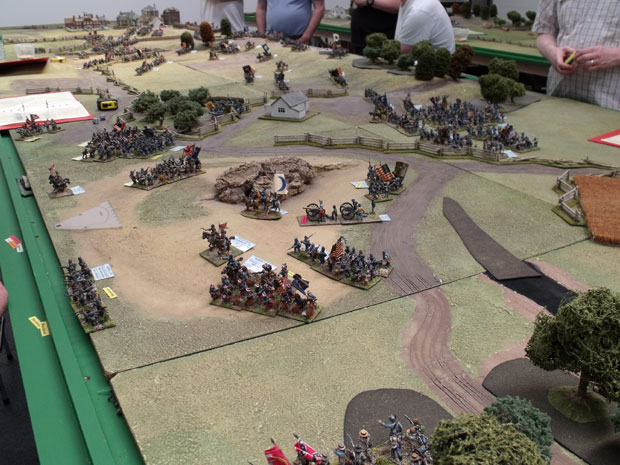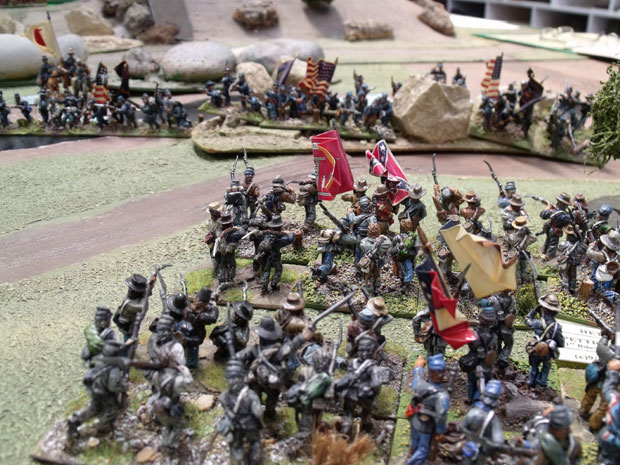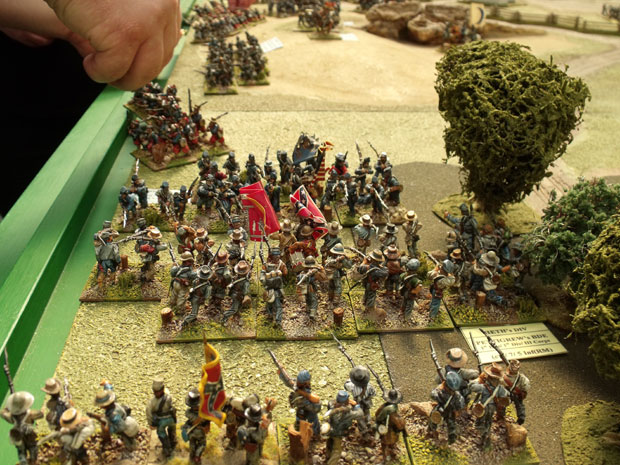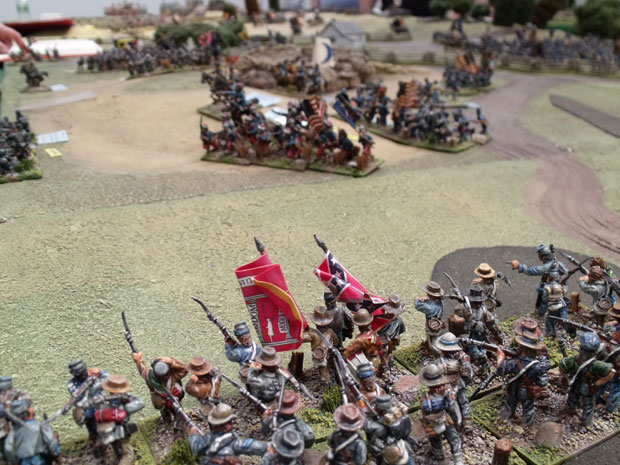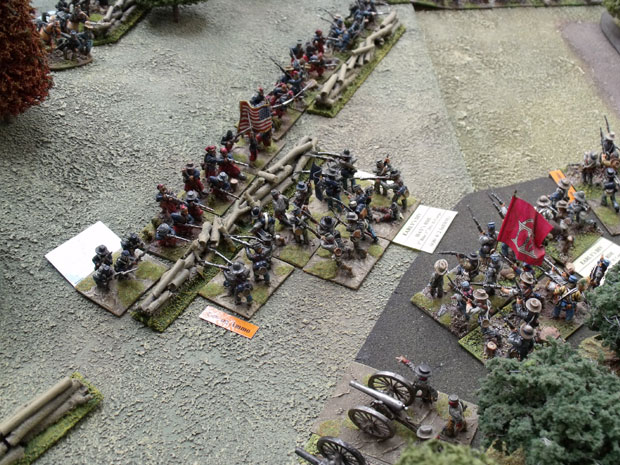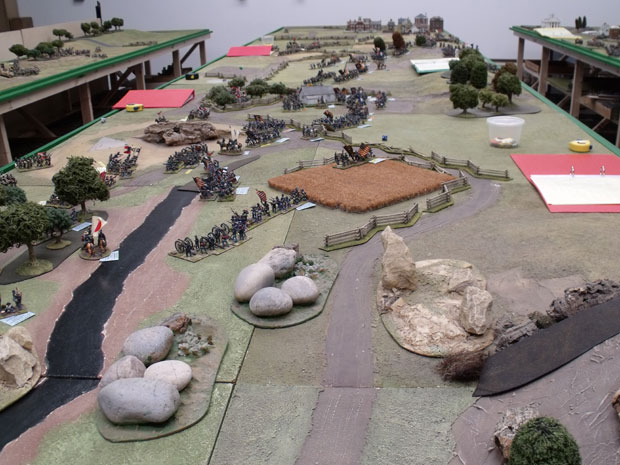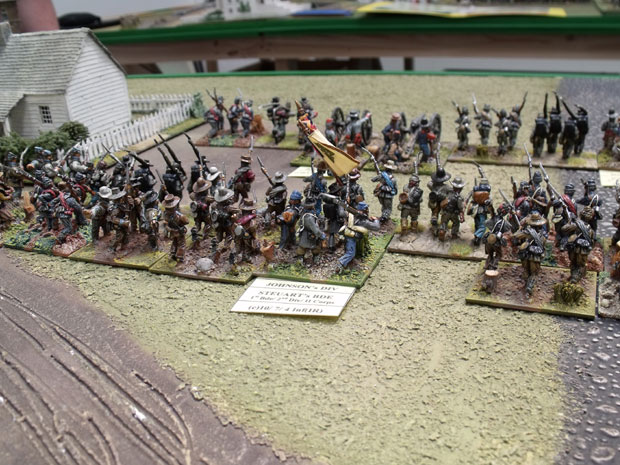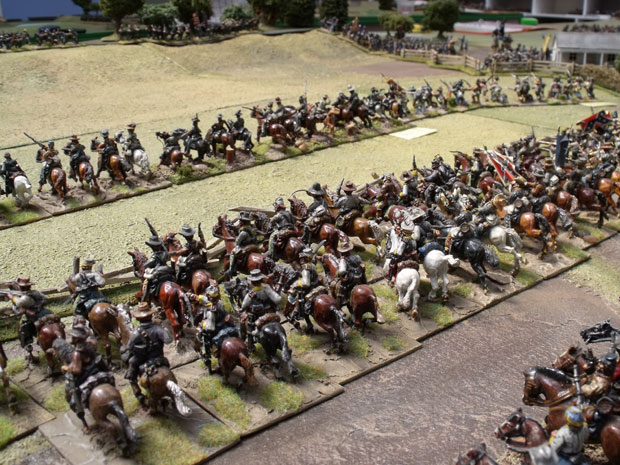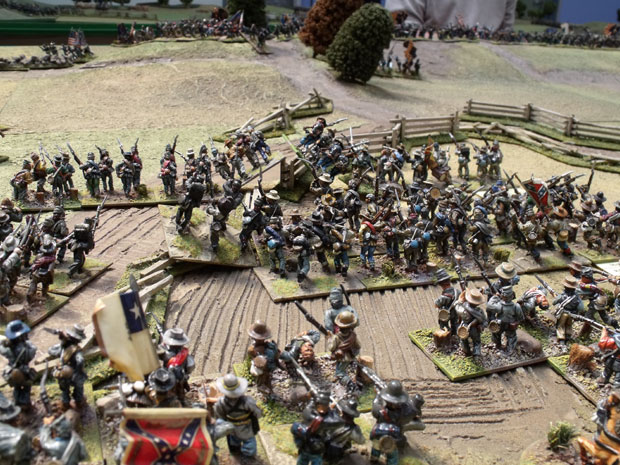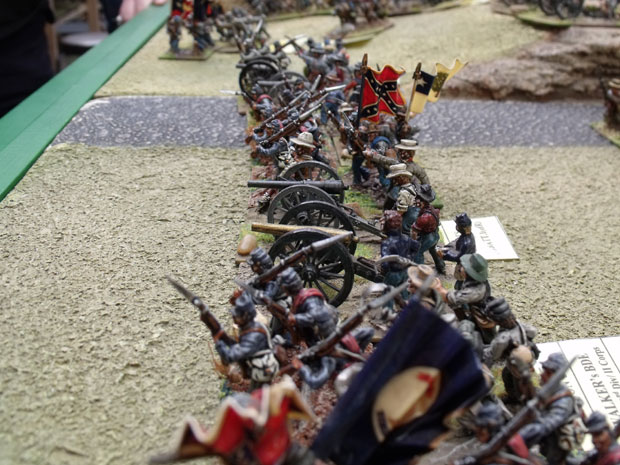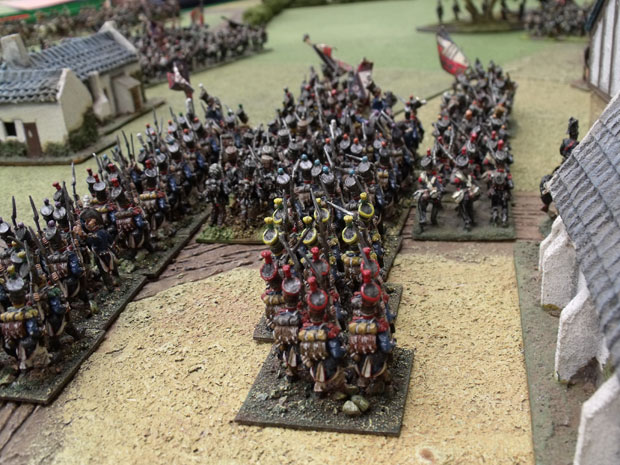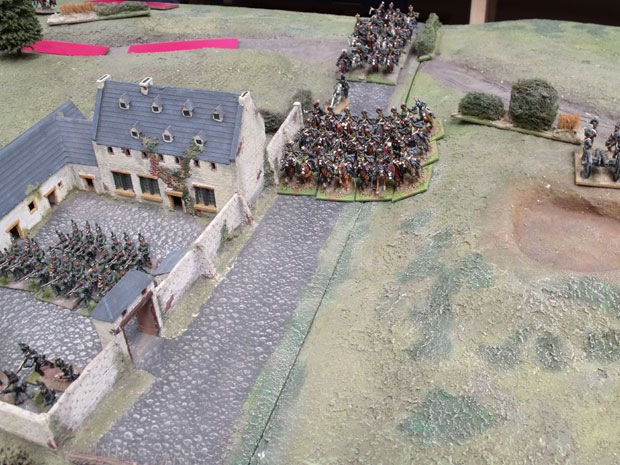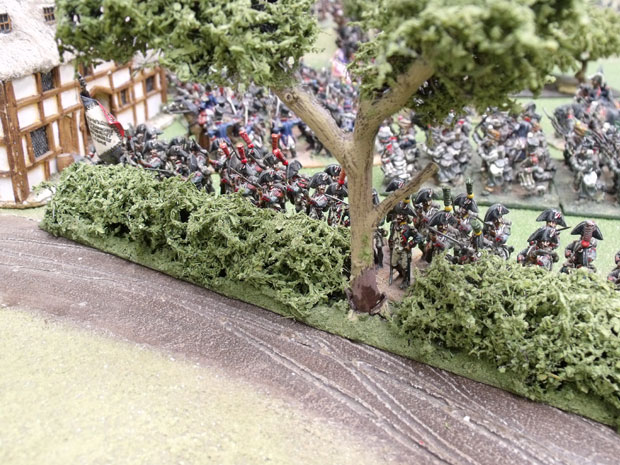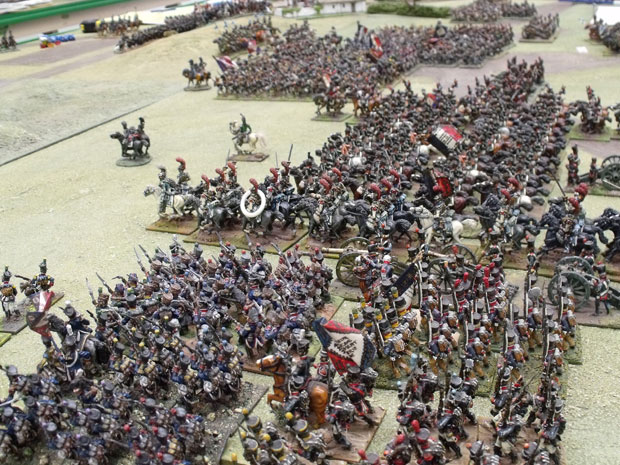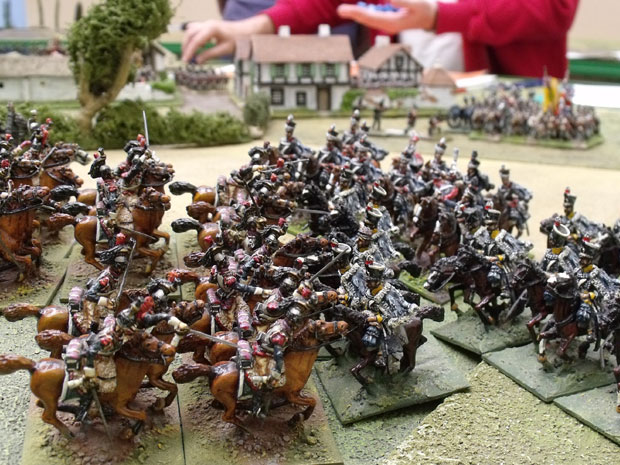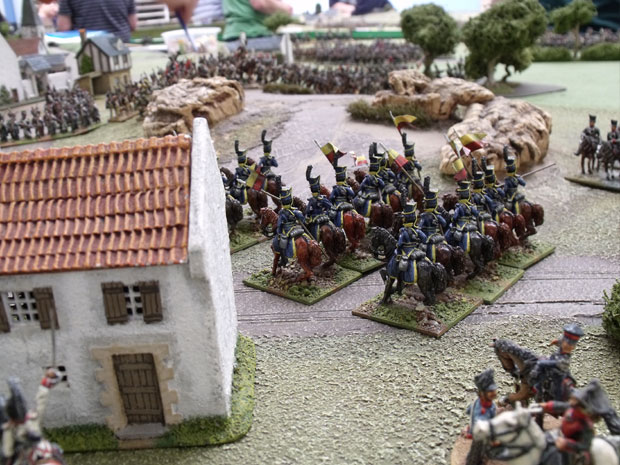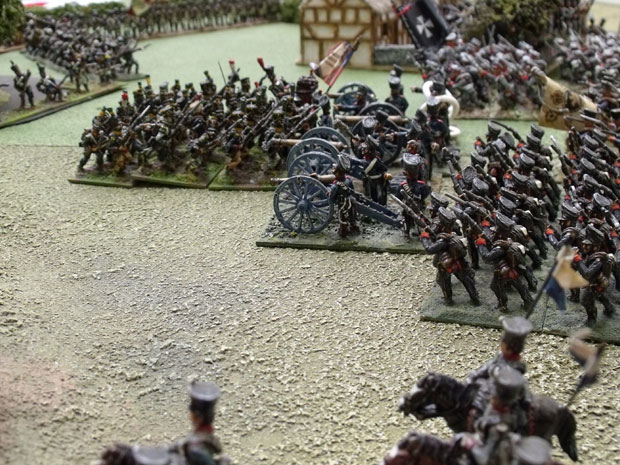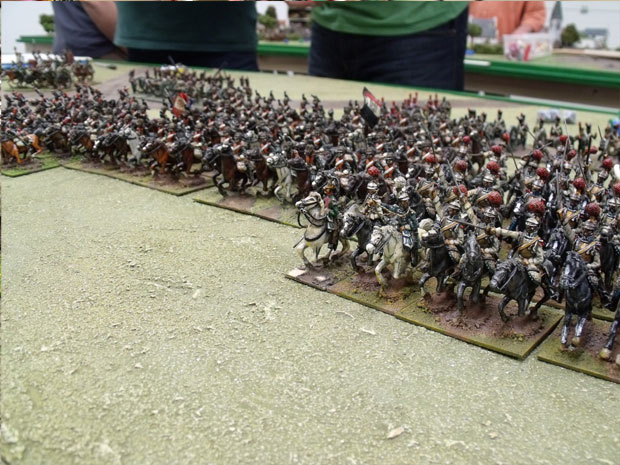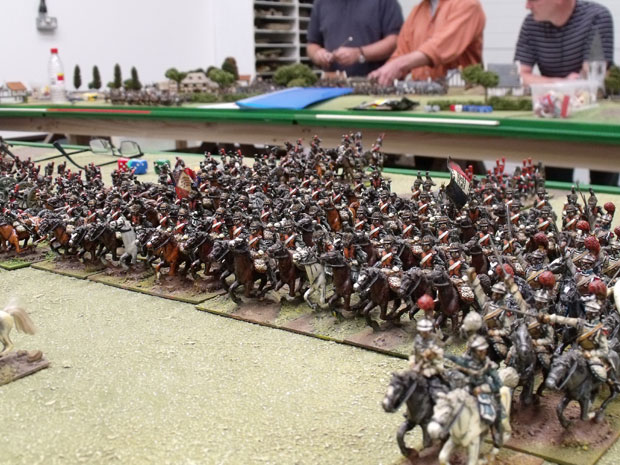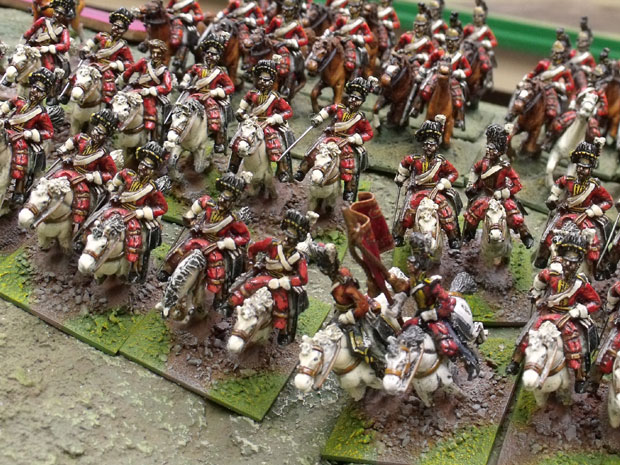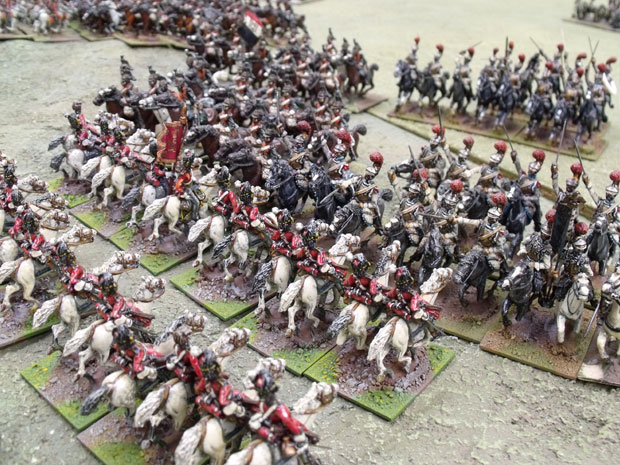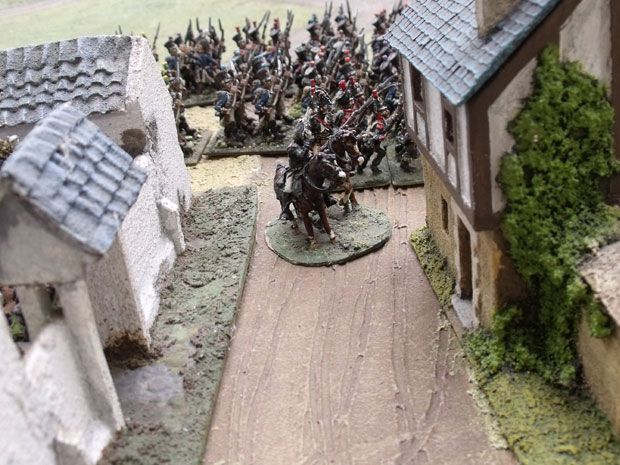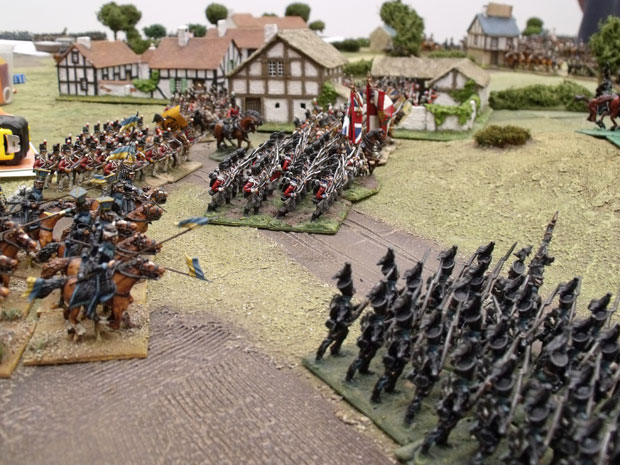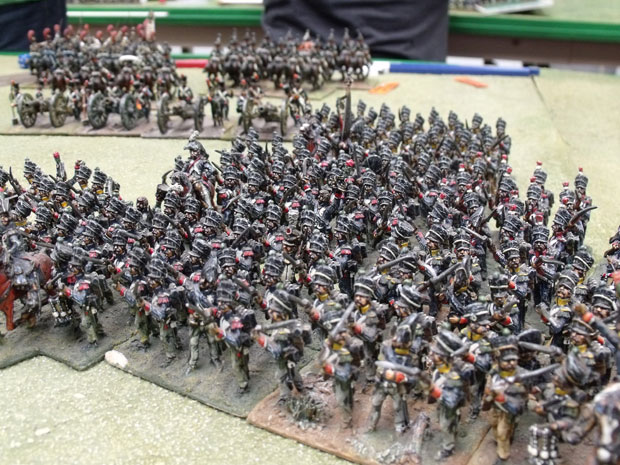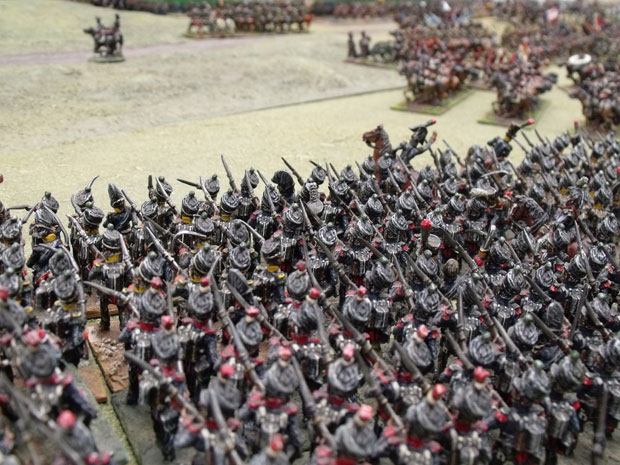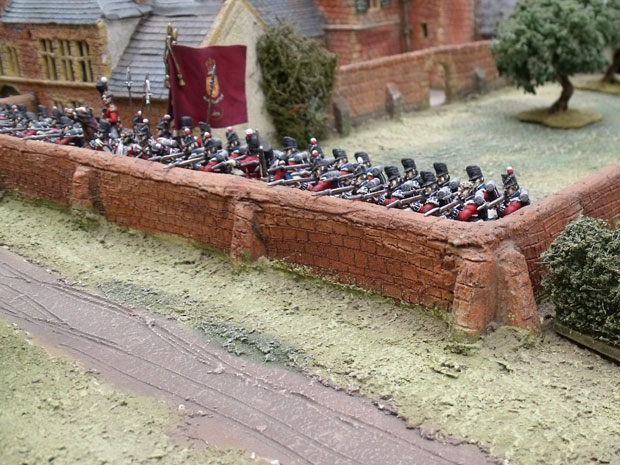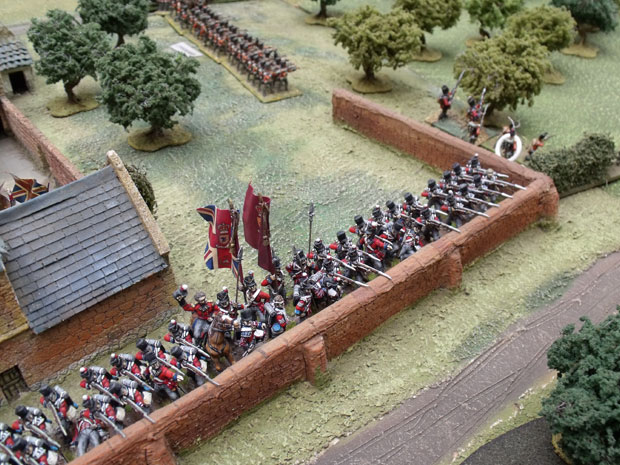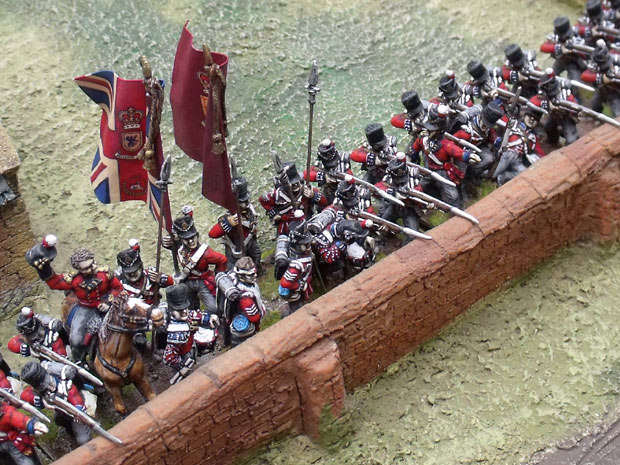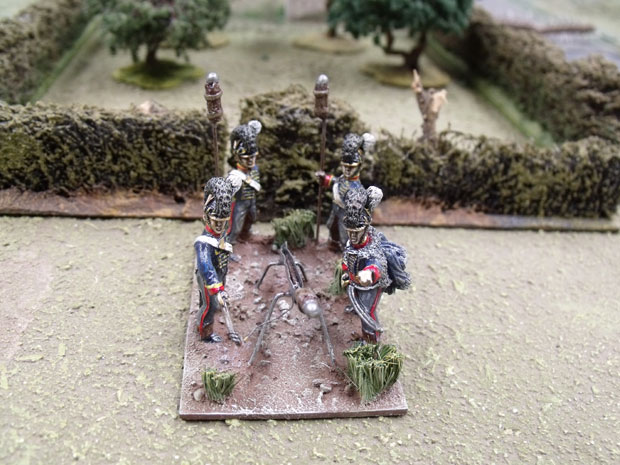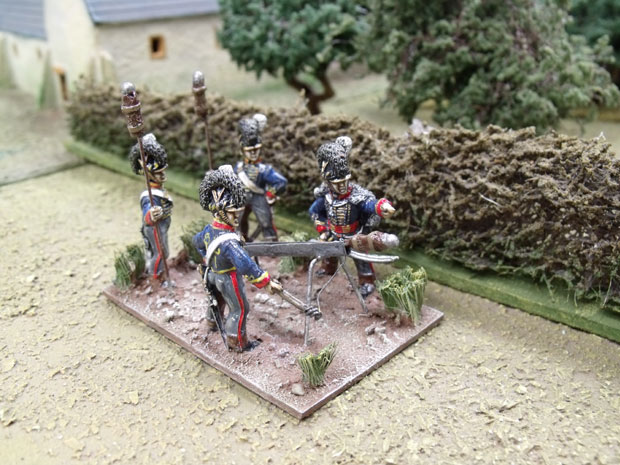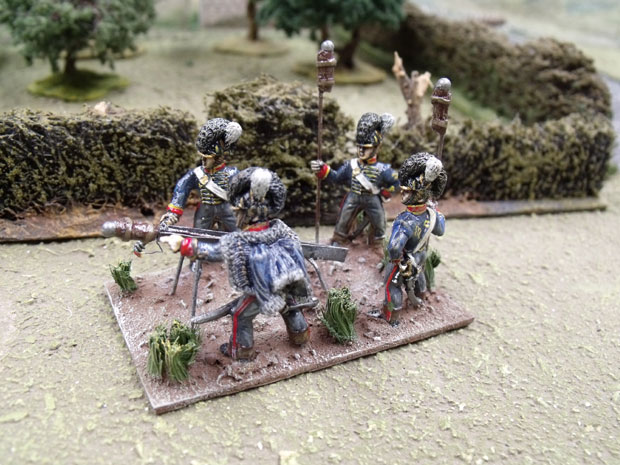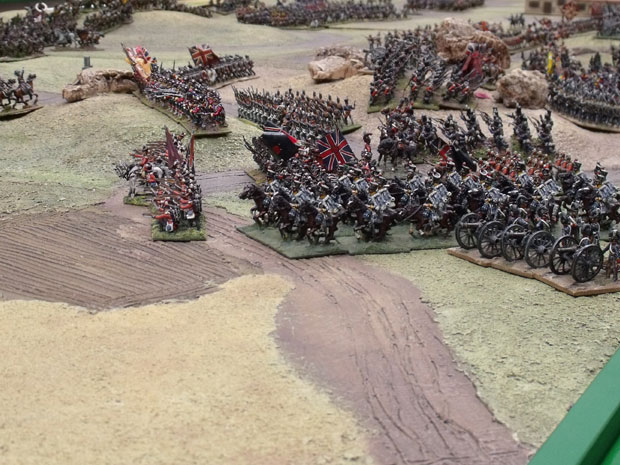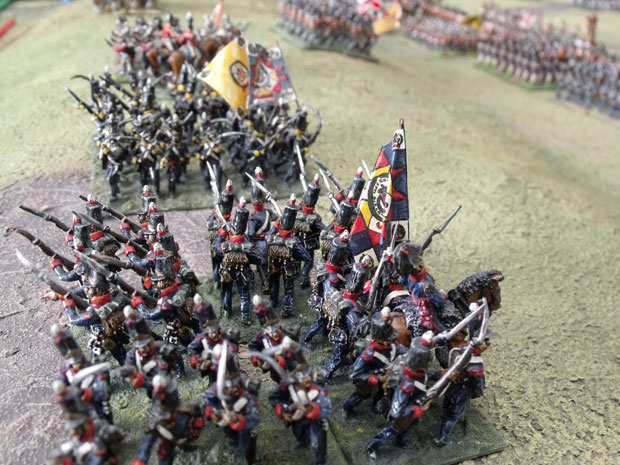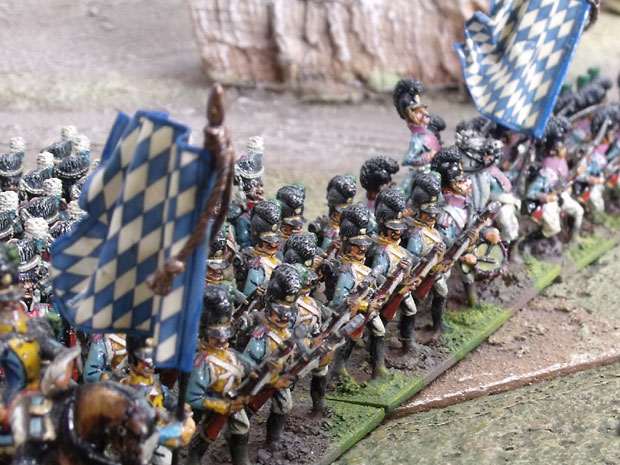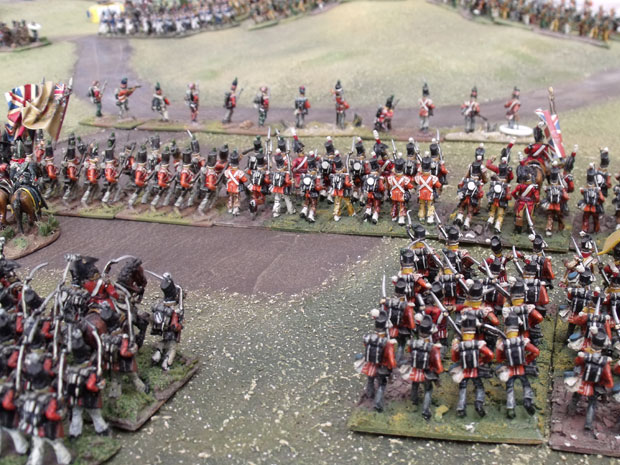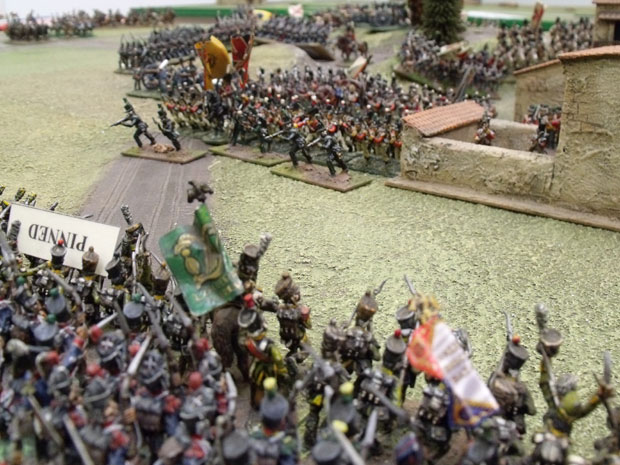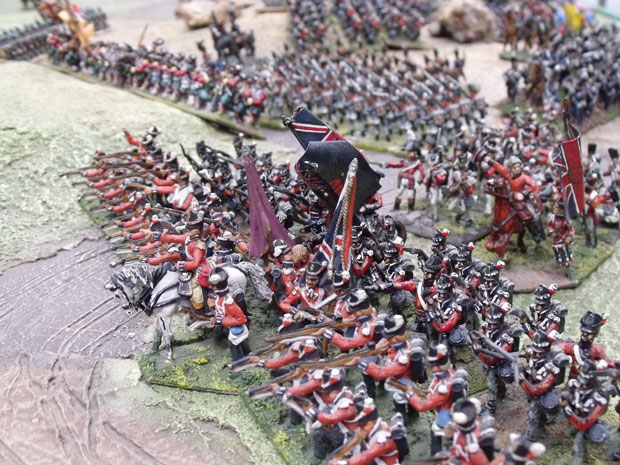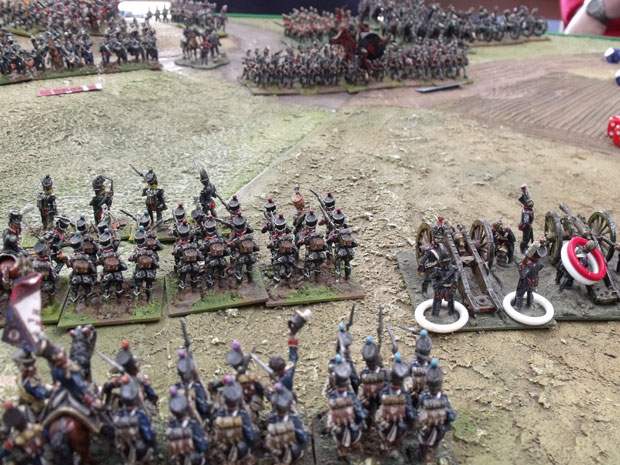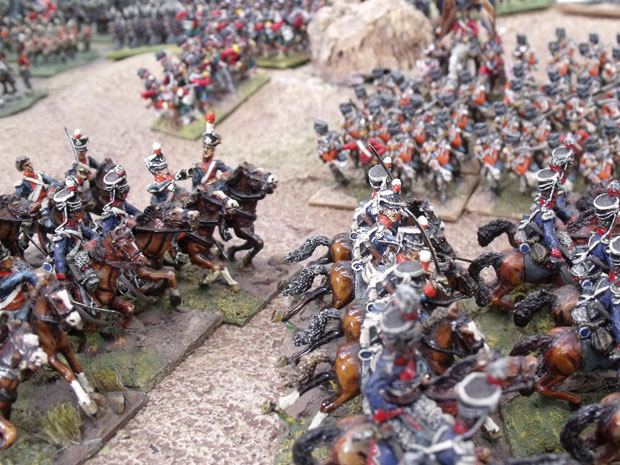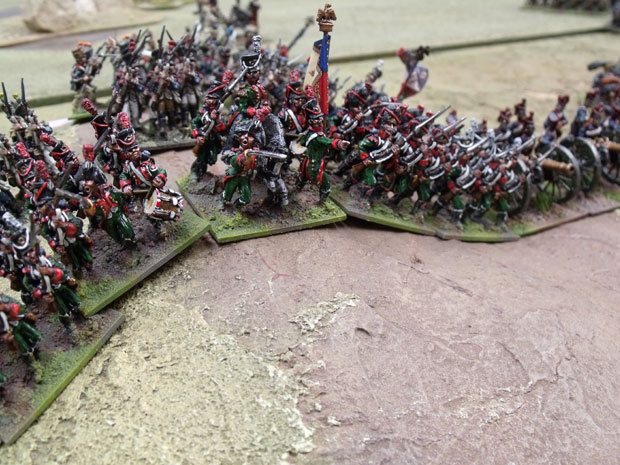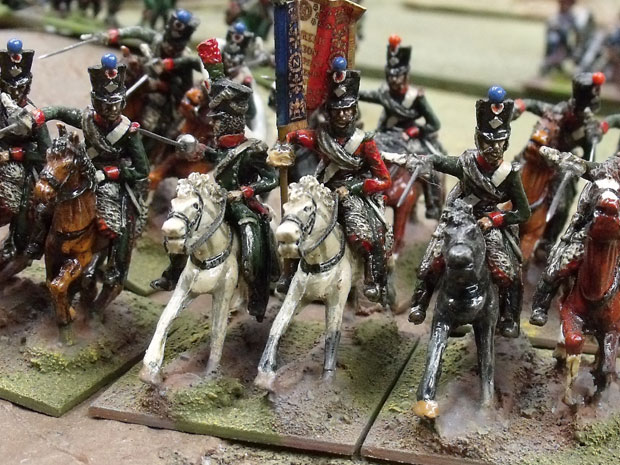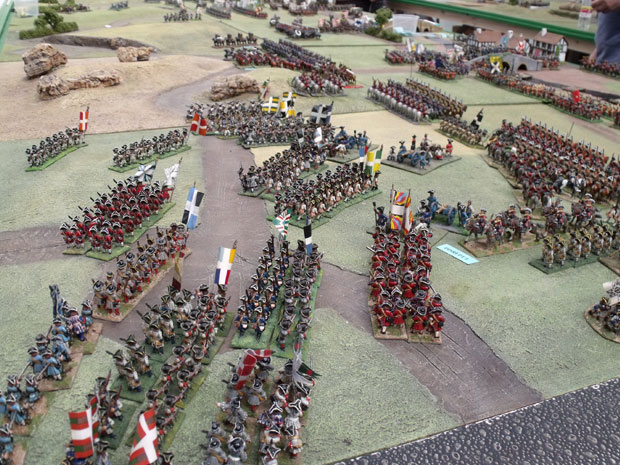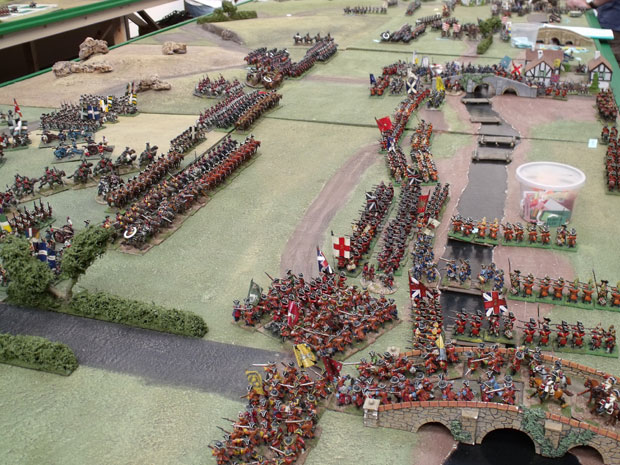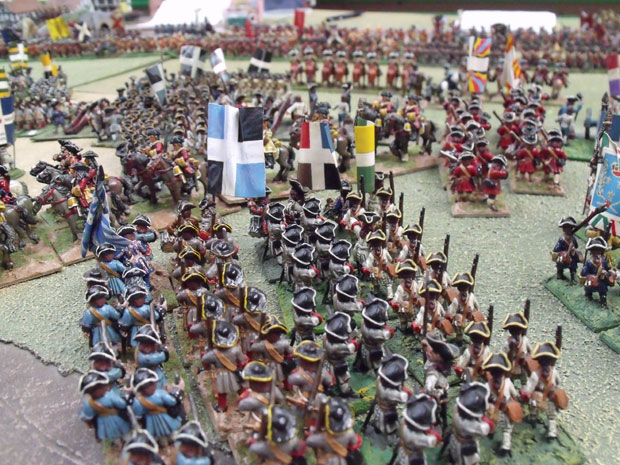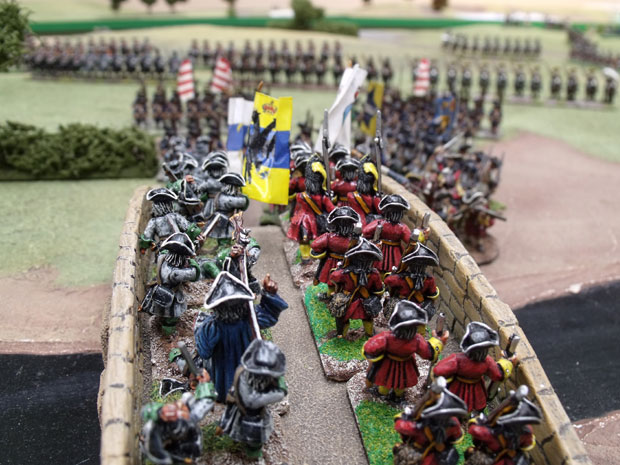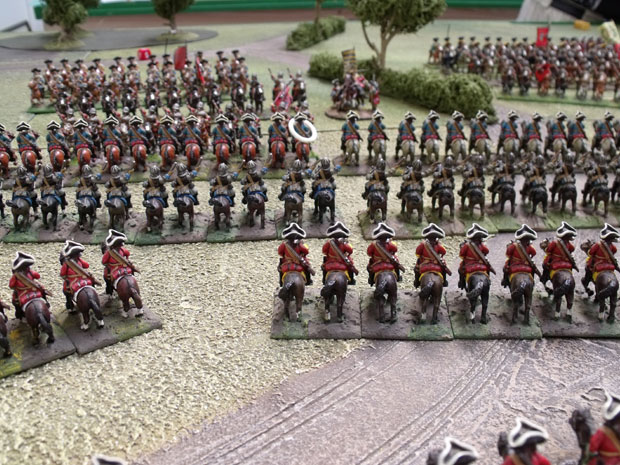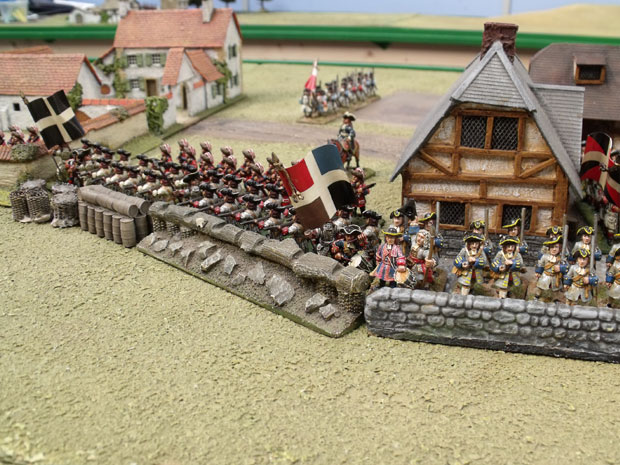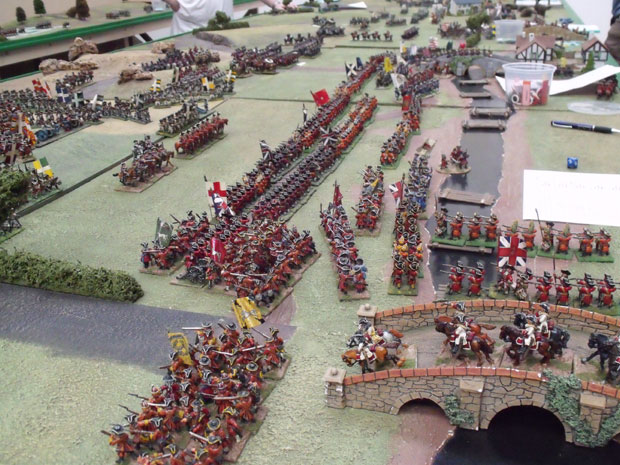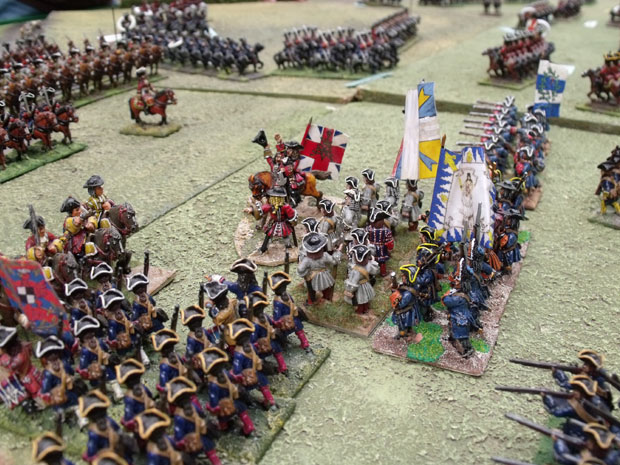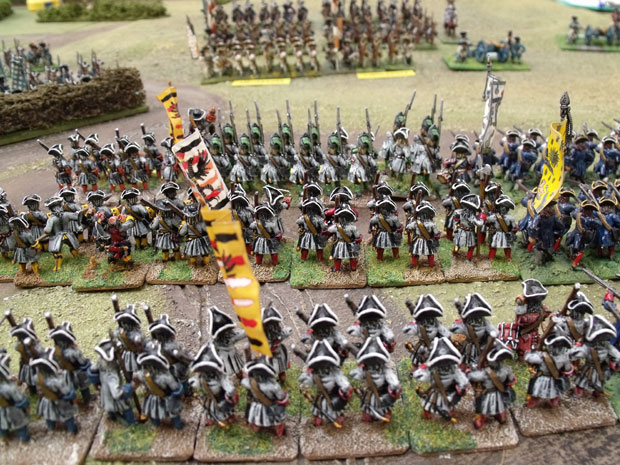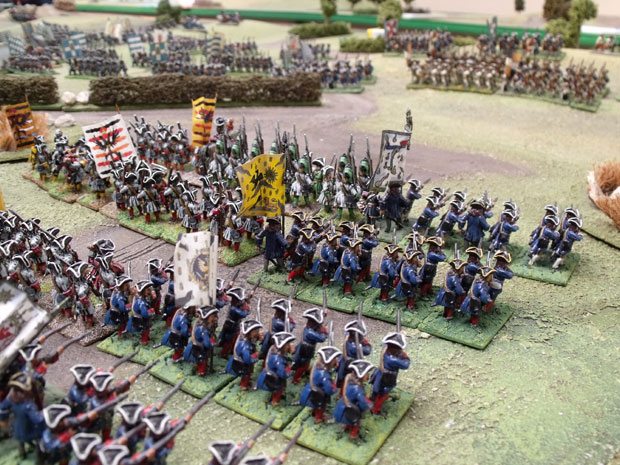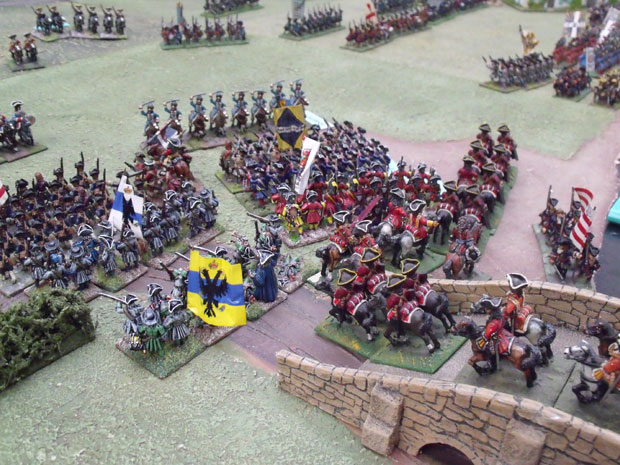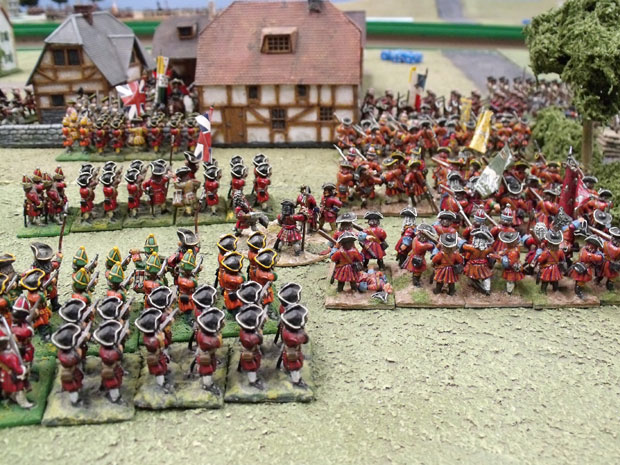Gettysburg re-played 22-24th May 2011.
Sedgewick bolsters the defence line on Cemetery Ridge on the 3rd July, second day here at the Wargames Holiday Centre.
I think I need to offer a measure of explanation in this Battle Report. Those of you that have played at the Wargames Holiday Centre will already be familiar with the methods we use. It goes without saying that we provide the stage, the backdrop, the props and you the public provide the WOW factor. Well this weekend was no exception. The rules are a slant on a mixture of Fire & Fury, along with Fire & Fury regimental. The weapon statistics, movement and command are from the new ruleset, while the makeup of the Orders of Battle are all brigades.
Bufords Cavalry Division in reserve.
After setting up the battlefield of Gettysburg the guys were given their Orders of Battle. Advised on deployment, reserves and special rules for terrain. In order to facilitate the “Fog of War” the armies were set up on tiles initially. The Confederates were allowed six “dummy” tiles to deploy as a division as well, in lieu of the Division hidden in the woods in front of Culp’s Hill.
A view of the battlefield on Saturday as the Union push forward to support Sickles Corps.
As we started the battle on the Friday night conducting the first move on tiles it certainly had a WOW factor. The Confederate Army of Virginia, conscious of it’s lack of manpower converged the best part of two Corps opposite the angle. Pickett was en-route and one of Ewell’s divisions (Early) was hidden in the woods north of Culp’s hill, due to burst forth on turn five. The Rebs needed a hammer blow.
Taken on the Sunday, this photo shows the determined efforts of Hill’s boys to drive back Reynolds Corps.
A.P. Hill’s Corps was deployed along the Peach Orchard and The Wheat field and was ordered to press an attack against Sickles III Corps, this being out on a salient of high ground, proud of the Union line.
Heth’s division attacks Union III Corps near the Wheatfield.
On the Union side the guys were a little stretched with their deployment initially, Sedgewick was coming in from the east, Pleasonton was out to the North East battling with Stuart and remnants of his Corps.
Heth’s division looks to cut Sickles off.
So with the scene set and the deployment available to the remaining Corps it was over to the Generals for the weekend.
Early in the day the Union began moving their troops from Reynold’s I Corps on to Round top, Little Round top was garrisoned by the artillery of I corps and a couple of brigades from the same corps.
The rest of the Union line stretched along the Cemetery ridge down to the Angle, then around and over Cemetery Hill and along to Culps Hill. The Confederates as mentioned earlier had converged two of their Corps under Longstreet and Ewell and began driving hard at the “Angle”, brigade after brigade began to “doublequick” toward the Union line. Howard’s XI Corps braced itself for the inevitable crunch and began moving the rest of their Corps west from Culp’s Hill to bolster the defence of Cemetery Hill and the Angle. This could be an ideal opportunity for Jubal Early’s division to arrive through the trees in front of Culp’s Hill.
Howards men manning the defences on top of Culp’s Hill.
Over on the Union left the troops began to manoeuvre to support Sickles III Corps, who instead of falling back, began to attack the Confederate divisions coming toward them. The Union V Corps was coming forward in direct support, while the I Corps came down from the Roundtops into the Devils Den and began advancing toward the Confederate divisions of A.P.Hill’s III Corps.
Fighting begins for the Peach Orchard.
The Union forces under Hancock massed on and behind Cemetery ridge began to pound the advancing Brigades from Longstreet’s Corps, the Union reserve batteries slowly moving into position in support of the II Corps.
Over on the Confederate right opposite the Angle the Divisions of Ewell’s Corps were pressing on, the terrain mean’t that they were coming in on a narrow front, but these were some of the best troops with many Crack and Veteran troops in their ranks.
The opening salvo’s from Cemetery ridge cut great swathes through the Confederate troops, the inferno of Cannon fire depleting the batteries ammunition on the ridge very quickly. So much so that three of the batteries had to stop firing to replenish their supplies. This wasn’t a problem though as the reserve batteries then took up the fight. The chap controlling the Cemetery ridge had a tremendous amount of luck, rolling “9” and “0”’s in rapid succession, causing the Rebs to remove two stands at a time from their Brigades. On the Rebs came, very much in the style of Pickett!
Into the wall of death came the rebel lines.
McLaws Division was linking the I Corps with II Corps, the Angle becoming a Hotbed of fire fights, the low wall providing a buttress for the Union defenders of Howards Corps. Ewells Boys pressed on supported by McLaws and Hood. It was at this point that Hood caught a shrapnel burst tearing his arm from his body. While this brave Confederate was removed from the field his division pressed up the slope to Cemetery ridge and the Angle.
Johnson’s Division pressed North past the Angle on to Cemetery Hill, Rodes linked with McLaws and charged into the Angle pressing the end of Cemetery ridge. The first turns of combat were desperate, with the Confederates temporarily capturing the Angle, only to be repulsed by Howard’s boys in blue! The Confederates rallied and went at it again, over the wall and on to the Union reserves in Howards Corps. It was around this time that news arrives from scouts of Pleasonton’s Corps of Confederates in the woods north of Culp’s Hill (due to the majority of the Union Cavalry remaining off table, this enhanced the spot by this force for any covert manoeuvring)
Early springs from the cover of the woods outside the defences of Culp’s Hill but is repulsed.
Howard’s remaining Divisions swung back to the defence of the hill, rushing back into their temporary bulwarks.
Meanwhile over in Devils Den, the Wheat field and the Peach Orchard, the battle raged on. Sickles Corps was conducting a desperate last stand while the Union’s I and V Corps pressed on in support. A.P.Hill was suffering something of a bloody nose, but his boys were pressing home the attack, pushing the Union III Corps back on it’s supports.
Lee began sending out requests for Stuart, where was he, what were the movements of the Union Cavalry?
The day closed with the Union holding all along the original line except for the round tops and the Angle, the former being bypassed on to the other side of Devils Den. Facing Hill’s Boys and drawing a line north east to the base of Cemetery ridge.
The Confederates held the Angle!
Just as the light faded, the troops of Sykes V Corps reported large bodies of Confederate Cavalry moving in behing Hill’s Corps, while on Cemetery ridge the troops of Hancock’s Corps reported firing upon Pickett’s division at extreme range.
Overnight the armies re-dressed their lines, the Union falling back on to the round tops and maintaining a line due North along Cemetery Ridge up to the Angle then North East to Cemetery Hill, then east along Culp’s Hill. During the night Early’s division was seen moving west to link up with the rest of Ewell’s Corps. The Union responded by manoeuvring parallel to them and supporting the rest of Howard’s Corps.
The battlefield early on Sunday morning, just before the players arrive and before the redeployment and collecting of stragglers.
A number of stragglers and lightly wounded came back to the colours over night and the battle began again in earnest. The Angle was attacked again, Lee overseeing the proceedings, both I and II Corps of the Army of Virginia thrust in to Howard’s defenders, the fighting was desperate.
Johnson’s Division pushing past the outskirts of Gettysburg, in an attept to capture Cemetery Hill.
Pickett took up Hood’s position opposite the Cemetery ridge, while Jeb Stuarts mounted brigades moved into a more central role preparing to take the ridge at a gallop! Pickett advanced to support the troops attacking the Union defenders of the Angle and all hell let loose as the lead brigades of Stuarts cavalry rode forward into range of the Union gun line on the ridge.
To the right of Stuart the troops of V Corps under Sykes began to swing on to the flank of the advancing cavalry, who themselves became flanked by the infantry from McLaws division who were looking to support the bold move of the confederates.
Over on the far right of the Confederate line opposite the round tops the Union again descended into the Den and began exchanging Volleys with the troops in Hill’s Corps, the exchange here became very bloody with Hill giving ground gradually.
Stuarts charge!
The Confederates believed their chance was to take cemetery ridge with the massed cavalry charge along with infantry support. Once again they stormed the bloody Angle and pushed up on to the Ridge, again they were thrown back. The first brigades of Reb cavalry closed on the Union line, and the very first brigade checked, pulled up then retreated out of close range. The brigade beside this passed them and smashed into the Union line, pushing the blue clad infantry back. On came the rest of Stuarts cavalry.
Pickett’s division attacks in support of Stuarts charge.
Now was the time for the Union to commit all their reserves, the gun line strengthened, Sedgewick, (who had been held in reserve all day) stepped up onto the ridge and opened fire on to the luckless cavalry. The firing was so intense that a whole brigade seemed to disappear. The rest of the Cavalry retired out of close range and a desultory exchange of fire began to take place.
The Union I Corps takes up position early on Saturday morning.
Pickett’s division was knocked back but Rodes division made some headway, faltering just at the top of the ridge.
Ewell’s Corps attacked the defenders of Cemetery Hill but again were repulsed from the ridge!
Johnson’s division battling it’s way toward Cemetery Hill
All in all the Union had won the day, holding the Confederates from their ridge, the idea of closing up the Corps, refusing their right flank and pushing in to the Angle nearly won it but the numbers told. In a valiant attempt the cavalry of Jeb Stuart looked as thought they were going to make it but they just couldn’t force the Union line back far enough.
All in all a great weekend, all the generals enjoyed their fight and went home talking of coming back for more!

